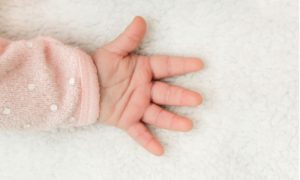 Palm reading – aka an assessment of palmar hyperlinearity – might be a quick and easy indicator of young people with loss-of-function filaggrin (FLG) null mutations who are at an increased risk of developing atopic dermatitis.
Palm reading – aka an assessment of palmar hyperlinearity – might be a quick and easy indicator of young people with loss-of-function filaggrin (FLG) null mutations who are at an increased risk of developing atopic dermatitis.
At an 18-year follow-up of the Melbourne Atopy Cohort Study (MACS), palmar line data, trans-epidermal water loss (TEWL) measures and DNA were collected from 311 probands and siblings from 157 families with a history of allergic disease.
The study found FLG-null mutations – one or more of the five most common mutations in Caucasian populations – in 12.2% of participants.
A quarter of participants (25.8%) had atopic dermatitis symptoms and 36.4% had evidence of palmar hyperlinearity.
Participants with both hyper-linear palms and current AD had the highest prevalence of FLG-null mutations (40.6%). In particular, seven or more vertical lines identified 89.5% of participants with FLG-null mutations.
TEWL measures were not associated with FLG-null mutations.
“Clinically graded palmar assessment, and vertical palm line counting, are very useful at identifying individuals who do not have a FLG gene null mutations (high specificity and negative predictive value),” the study said.
“While individuals with hyperlinearity have increased risk of FLG null mutations, only around 20% will have such a mutation, making confirmatory genetic testing necessary.”
The study, led by Associate Professor Adrian Lowe, concluded that assessment in early life would have therapeutic implications and even career implications for affected children.
Professor Lowe, Deputy Leader of the University of Melbourne’s Allergy and Lung Health Unit, told the limbic that people with one of the FLG-null mutations have about twice the risk of developing eczema.
“We do have some evidence to say that people with these filaggrin-null mutations are at greater risk of getting things like cat allergy if they are exposed to cats but we don’t yet know if the treatment for these people should be different.”
He said it would however make sense that they respond to treatment differently because of their impaired skin barrier.
“What I want to know is if we can do this in babies. Can we just look at a baby’s palm and tell whether or not they have one of these null mutations because then we can predict if they are at increased risk of going on to develop eczema and then we can start doing things like treating their skin differently and making sure we avoid some of these triggers that might lead to sensitisation and allergic disease down the track.”
He said the PEBBLES study – investigating whether a regular application of emollients in babies can build their skin barrier and prevent allergic disease – was still recruiting infants.
“One of our hypotheses is they are going to respond better if they have one of these filaggrin-null mutations and if that is the case, and we can predict which children have the mutation based on what their palm looks like in early life, we could have something that is an intervention that can identify high-risk babies and then help prevent them from developing these conditions.”
He added that genetic testing was quite expensive and at the moment he wasn’t an advocate for it. But some people were aware of the option and asking for it.
“This [palmar linearity] is a very quick and easy clinical sign to say your palm isn’t particularly lined, it’s really unlikely you’ve got one of these filaggrin-null mutations even if you do have eczema.”